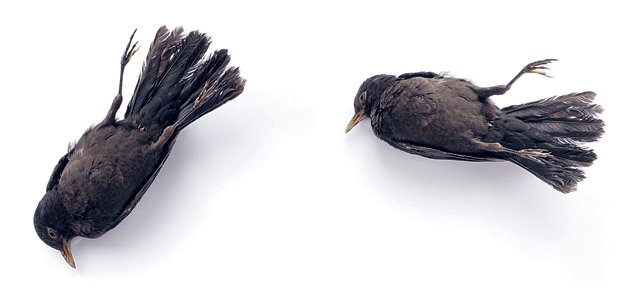Aflockalypse Now?
April 1, 2011

It started with several thousand red-winged black birds found dead in Arkansas and other birds soon after in Louisiana and Sweden. Next, it was 100,000 drum fish in Arkansas (again), snapper in New Zealand and Maryland, and crabs in Britain.
It’s no wonder people were starting to wonder if the Mayan prediction that the world would end in 2012 was true, or that the events were an echo of the apocalyptic prophecies outlined in the final book of the Bible, Revelation.
But is the phenomena really portentous of something in our future, akin to the plagues that Moses brought on Egypt (see Exodus 7–11) heralding the imminent departure of the Hebrews for the Promised Land? Perhaps not.
The immediate cause of death for the Arkansas birds was described by veterinarians as “blunt trauma to the organs.” I’m not a veterinarian or anything close to being a scientist, but if I fell from the sky, I think I might suffer some blunt trauma too. But what caused them to fall in the first place?
In an interview with the London Telegraph, Karen Rowe, a senior ornithologist with the Arkansas Game and Fish Commission, said, “. . . there is nothing there to justify a conspiracy theory. They just got flushed from their roost, crashed into things and died.”
But is the phenomena a portent of the future?
Paul Slota, a spokesman for the US Ecological Survey, which has been tracking mass animal deaths since the 1970s, told The Wall Street Journal that mass animal deaths are, in fact, not uncommon. “In the past 10 years we’ve logged 188 cases just involving birds, with mortality exceeding 100 animals per event,” he said.
It appears that such events are not unusual and can be explained. The Washington Post reported that the two million dead fish in Maryland may simply have been the result of an unusual cold snap.
According to Melanie Driscoll, a biologist with the Gulf of Mexico and Mississippi flyway, “In Arkansas, we have eyewitness accounts that professional grade fireworks were set off in a town near a known blackbird roost and that birds flushed from the roost flew in a single direction at lower levels than they would normally fly. We know that they cannot see well in the dark and we know that they were seen crashing into buildings and cars and poles.”
Driscoll also gave a bit of perspective to the events. “Five billion birds die in the US every year, so statistically some will die at the same time. The population of red-winged blackbirds is more than 200 million and they fly in flocks of a hundred thousand to two million. So 5000 birds sounds like a lot but really it is a relative number.”
The seemingly ominous nature of these events may tempt some to interpret it as a sort of sign of the times. But such extrapolation needs caution—and for Christians, knowledge of what the Bible actually states about the signs of Christ’s return.
Dying animals are not among those things predicted, neither in the warnings given by Christ nor by the apostle John in Revelation.
The challenge however, is not to fall into the trap of rationalising away every and all natural phenomena that might rightly be described as apocalyptic (although not aflockalyptic) occurring in the world around us right now. The temptation is to argue that we learn nothing from nature—benign or malevolent—arguing that such things are cyclical, merely repetitions of what the record of nature in geologic columns, ice-cores and bristlecone pines reveal of the past.
Notably, as the apostle Peter, writes, such rationalisation by people is in itself a sign of the last days, warning “that in the last days scoffers will come, scoffing and indulging their lusts and saying, ‘Where is the promise of [Jesus’] coming? For ever since our ancestors died, all things continue as they were from the beginning of creation!’ They deliberately ignore this fact, that by the word of God heavens existed long ago and an earth was formed out of water and by means of water, through which the world of that time was deluged with water and perished” (2 Peter 3:3–6, NRSV).
I like how Isaiah, the Old Testament prophet, describes the future: “. . . the heavens will vanish like smoke, the earth will wear out like a garment and its inhabitants die like flies” (Isaiah 51:6).
The main lesson we can learn from dead fish and dead birds, floods and fires and famines is that anyone who puts their future plans into this world is in for a disappointment. Nature, threadbare and fraying, tells us this in each succeeding natural disaster. But God, through Isaiah, goes on to tell us there is no cause to fear, saying, “My salvation will be forever.”
the real signs of Christ’s return
Jesus Himself along with Bible writer, warned against predicting the time of His second coming, but He does tell us to investigate the prophecies that indicate that it is imminent, giving specific world events so that we can be aware and prepared. Here are some:
- War (Matthew 24:6, 7)
- Increased anxiety and stress (Luke 21:26)
- Famine and earthquakes (Matthew 24:7)
- Capitalism and globalism (James 5:1–8)
- Increased knowledge (Daniel 12:4)
- Moral collapse (Matthew 24:37)
- A preoccupation with pleasure (2 Timothy 3:1–5)
- Breakdown in love relationships (Matthew 24:12)
- People ridiculing the message of the Second Coming (2 Peter 3:3, 4)
- Deception through false miracles, prophets and Christs (Matthew 24:24)
- The rise of spiritualism (1 Timothy 4:1)
- Gospel preached all over the world (Matthew 24:14)
SOURCE: The Prophetic Code correspondence course by Adventist Discovery Centre.









